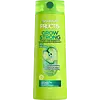What's inside
What's inside
 Key Ingredients
Key Ingredients

 Benefits
Benefits

 Concerns
Concerns

 Ingredients Side-by-side
Ingredients Side-by-side

Water
Skin ConditioningAmmonium Lauryl Sulfate
CleansingCocamidopropyl Betaine
CleansingHydrolyzed Keratin
HumectantHydrolyzed Silk
HumectantCocodimonium Hydroxypropyl Hydrolyzed Wheat Protein
CleansingCitrus Grandis Fruit Extract
AstringentCitrus Medica Limonum Peel Extract
EmollientDicaprylyl Ether
EmollientQuaternium-15
PreservativePropylene Glycol
HumectantLauryl Alcohol
EmollientCitric Acid
BufferingAmmonium Chloride
BufferingAscorbic Acid
AntioxidantTetrasodium EDTA
Methylchloroisothiazolinone
PreservativeMethylisothiazolinone
PreservativeParfum
MaskingCI 61570
Cosmetic ColorantWater, Ammonium Lauryl Sulfate, Cocamidopropyl Betaine, Hydrolyzed Keratin, Hydrolyzed Silk, Cocodimonium Hydroxypropyl Hydrolyzed Wheat Protein, Citrus Grandis Fruit Extract, Citrus Medica Limonum Peel Extract, Dicaprylyl Ether, Quaternium-15, Propylene Glycol, Lauryl Alcohol, Citric Acid, Ammonium Chloride, Ascorbic Acid, Tetrasodium EDTA, Methylchloroisothiazolinone, Methylisothiazolinone, Parfum, CI 61570
Water
Skin ConditioningSodium Laureth Sulfate
CleansingCocamidopropyl Betaine
CleansingSodium Lauryl Sulfate
CleansingGlycol Distearate
EmollientSodium Chloride
MaskingAmodimethicone
PPG-5-Ceteth-20
EmulsifyingParfum
MaskingCitric Acid
BufferingSodium Benzoate
MaskingSodium Hydroxide
BufferingCoco-Betaine
CleansingPyrus Malus Fruit Extract
Skin ConditioningSalicylic Acid
MaskingGuar Hydroxypropyltrimonium Chloride
Skin ConditioningTrideceth-6
EmulsifyingCarbomer
Emulsion StabilisingLinalool
PerfumingNiacinamide
SmoothingPyridoxine Hcl
Skin ConditioningLimonene
PerfumingHexyl Cinnamal
PerfumingCetrimonium Chloride
AntimicrobialSaccharum Officinarum Extract
MoisturisingCitronellol
Perfuming2-Oleamido-1,3-Octadecanediol
Skin ConditioningPyrus Malus Fruit Water
MaskingFumaric Acid
BufferingHydroxypropyltrimonium Lemon Protein
HumectantPhenoxyethanol
PreservativeCitrus Limon Peel Extract
EmollientLeuconostoc/Radish Root Ferment Filtrate
AntimicrobialCamellia Sinensis Leaf Extract
AntimicrobialWater, Sodium Laureth Sulfate, Cocamidopropyl Betaine, Sodium Lauryl Sulfate, Glycol Distearate, Sodium Chloride, Amodimethicone, PPG-5-Ceteth-20, Parfum, Citric Acid, Sodium Benzoate, Sodium Hydroxide, Coco-Betaine, Pyrus Malus Fruit Extract, Salicylic Acid, Guar Hydroxypropyltrimonium Chloride, Trideceth-6, Carbomer, Linalool, Niacinamide, Pyridoxine Hcl, Limonene, Hexyl Cinnamal, Cetrimonium Chloride, Saccharum Officinarum Extract, Citronellol, 2-Oleamido-1,3-Octadecanediol, Pyrus Malus Fruit Water, Fumaric Acid, Hydroxypropyltrimonium Lemon Protein, Phenoxyethanol, Citrus Limon Peel Extract, Leuconostoc/Radish Root Ferment Filtrate, Camellia Sinensis Leaf Extract
Ingredients Explained
These ingredients are found in both products.
Ingredients higher up in an ingredient list are typically present in a larger amount.
Citric Acid is an alpha hydroxy acid (AHA) naturally found in citrus fruits like oranges, lemons, and limes.
Like other AHAs, citric acid can exfoliate skin by breaking down the bonds that hold dead skin cells together. This helps reveal smoother and brighter skin underneath.
However, this exfoliating effect only happens at high concentrations (20%) which can be hard to find in cosmetic products.
Due to this, citric acid is usually included in small amounts as a pH adjuster. This helps keep products slightly more acidic and compatible with skin's natural pH.
In skincare formulas, citric acid can:
While it can provide some skin benefits, research shows lactic acid and glycolic acid are generally more effective and less irritating exfoliants.
Most citric acid used in skincare today is made by fermenting sugars (usually from molasses). This synthetic version is identical to the natural citrus form but easier to stabilize and use in formulations.
Read more about some other popular AHA's here:
Learn more about Citric AcidCocamidopropyl Betaine is a fatty acid created by mixing similar compounds in coconut oil and dimethylaminopropylamine, a compound with two amino groups.
This ingredient is a surfactant and cleanser. It helps gather the dirt, pollutants, and other impurities in your skin to be washed away. It also helps thicken a product and make the texture more creamy.
Being created from coconut oil means Cocamidopropyl Betaine is hydrating for the skin.
While Cocamidopropyl Betaine was believed to be an allergen, a study from 2012 disproved this. It found two compounds in unpure Cocamidopropyl Betaine to be the irritants: aminoamide and 3-dimethylaminopropylamine. High-grade and pure Cocamidopropyl Betaine did not induce allergic reactions during this study.
Learn more about Cocamidopropyl BetaineParfum is a catch-all term for an ingredient or more that is used to give a scent to products.
Also called "fragrance", this ingredient can be a blend of hundreds of chemicals or plant oils. This means every product with "fragrance" or "parfum" in the ingredients list is a different mixture.
For instance, Habanolide is a proprietary trade name for a specific aroma chemical. When used as a fragrance ingredient in cosmetics, most aroma chemicals fall under the broad labeling category of “FRAGRANCE” or “PARFUM” according to EU and US regulations.
The term 'parfum' or 'fragrance' is not regulated in many countries. In many cases, it is up to the brand to define this term.
For instance, many brands choose to label themselves as "fragrance-free" because they are not using synthetic fragrances. However, their products may still contain ingredients such as essential oils that are considered a fragrance by INCI standards.
One example is Calendula flower extract. Calendula is an essential oil that still imparts a scent or 'fragrance'.
Depending on the blend, the ingredients in the mixture can cause allergies and sensitivities on the skin. Some ingredients that are known EU allergens include linalool and citronellol.
Parfum can also be used to mask or cover an unpleasant scent.
The bottom line is: not all fragrances/parfum/ingredients are created equally. If you are worried about fragrances, we recommend taking a closer look at an ingredient. And of course, we always recommend speaking with a professional.
Learn more about ParfumWater. It's the most common cosmetic ingredient of all. You'll usually see it at the top of ingredient lists, meaning that it makes up the largest part of the product.
So why is it so popular? Water most often acts as a solvent - this means that it helps dissolve other ingredients into the formulation.
You'll also recognize water as that liquid we all need to stay alive. If you see this, drink a glass of water. Stay hydrated!
Learn more about Water